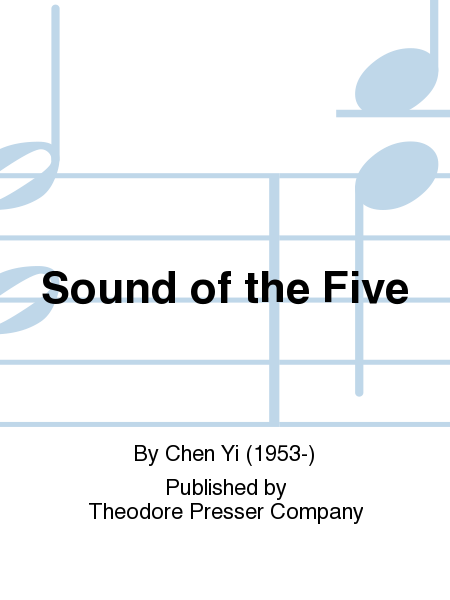Sound of the Five
for Solo Cello and String Quartet
-
Ships in 2 to 3 weeks
Details
Description
SKU: PR.114410530
For Solo Cello and String Quartet. Composed by Chen Yi. Saddle. Contemporary. Set of Score and Parts. With Standard notation. Composed 1998. 42+19+19+17+17+17 pages. Duration 20 minutes. Theodore Presser Company #114-41053. Published by Theodore Presser Company (PR.114410530).UPC: 680160015351. 8.5 x 11 inches.
SOUND OF THE FIVE is written for Western instruments suited to approximate the sound and style ofthe traditional Chinese lusheng, set bells and drums, hsiao, and ch’in. Each of the four movements (LushengEnsemble; Echoes of the Set Bells; Romance of Hsiao & Ch’in; Flower Drums in Dance) is inspired by various aspects of ancient Chinese music and rhythm.
Commissioned by the Eastman School of Music, University of Rochester in New York, through the generosity of Dr. Henry Hwang and the Far East National Bank of Los Angeles, California, for Mimi Hwang and the Ying Quartet, Sound of the Five includes four movements: 1. Lusheng Ensemble; 2. Echoes of the Set Bells; 3. Romance of Hsiao and Ch’in; 4. Flower Drums in Dance. The work is written for western instruments which will reproduce the sound and style of lusheng, set bells and drums, hsiao and ch’in — the Chinese traditional instruments.The Lusheng is an age-old bamboo mouthpipe. Villagers of various minorities in Southwestern China often play together while dancing in lusheng ensembles to celebrate the spring holidays. The instruments from the lusheng family are ranged from bass (23 feet long) to soprano (about 12 inches) in the ensemble. The lead player performs with the smallest lusheng, dancing in complicated movements around the ensemble, which responds with colorful pentatonic harmonies in the background. The history of the set bells can be traced back to the pre-Qing period (Shang Dynasty, c.16th century-11th century B.C.). Made from bronze, every bell produces two tones (played in different positions), which can form a major or minor third, or major second. Grouped from three to sixty-four bells as a set, it is a melodic instrument, played in orchestra at court. Hsiao is a vertical bamboo flute which carries lyrical melodies through delicate lines, grace notes and silence. Ch’in is a two thousand year old Chinese 7-string zither, which has a rich repertoire in the history of Chinese music and literature. In Ch’in performance, it produces various articulations by different fingerings of plucking and vibratos, played with both hands. These two instruments are often played together, and produce a good balance for sonority and timbre. The Flower drum has membranes on both ends. It’s also the name of a popular folk dance in the Han majority. Groups of people play the flower drums hung on their waists in dynamic rhythms while dancing in open field or in marches, to celebrate happy occasions. The gesture is vivid and the sound strong and passionate.In the first movement, Lusheng Ensemble, the cello solo part plays the lead role and the quartet represents the ensemble. Imaging the bell sound from distance, five strings are merged together with mysterious harmonics in the second movement Echoes of the Set Bells. In the third, Romance of Hsiao and Ch’in, the cello transmits a lyrical sense to express the composer’s love for humanities, while the string quartet sounding like an enlarged Ch’in symbolizes the nature. The finale Flower Drums in Dance comes back to an energetic scene. The rhythmic design is inspired by Chinese traditional percussion ensemble music. Making the drum sound, the string quartet accompanies the singing cello, building up a momentum and leading the music to a lively ending.—Chen Yi“Together with [the] cellist…the quartet imitated the sounds of different Chinese instruments in each of its four movements…A tremendous technical challenge for the players, this composition also stresses the adaptation of Western atonality and musical structure to the timbres of Chinese instruments.”—Joe & Elizabeth Kahn, Independent Weekly.

 Share
Share